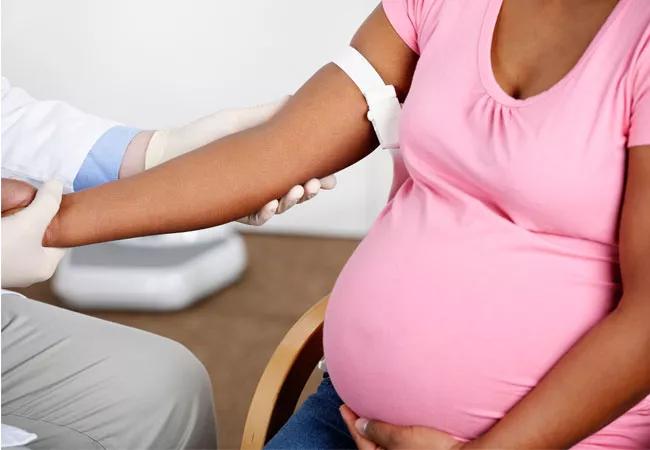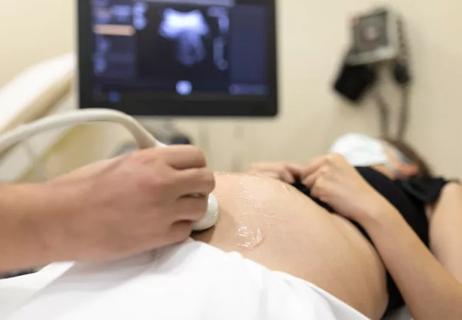Biomarkers can predict who is at risk for severe disease

A new a test can predict, with up to 96% accuracy, whether patients with new-onset hypertension in pregnancy are likely to develop severe preeclampsia within two weeks. Since delivery of the infant is the only cure for preeclampsia, that information may be useful to physicians and patients as they consider whether to deliver immediately or to delay delivery to optimize fetal development.
Announcement of the test’s approval by the U.S. Food and Drug Administration in May (it was already available in Europe) spurred widespread press coverage, much of it heralding it as a game changer at a time when hypertension has become one of the most common complications of pregnancy. A New York Times article quoted one physician calling it “groundbreaking” and “revolutionary.”
Advertisement
Cleveland Clinic is a non-profit academic medical center. Advertising on our site helps support our mission. We do not endorse non-Cleveland Clinic products or services. Policy
But the test is just one tool with potential risks and benefits, and it will be important to watch for its impact in practice, says Adina Kern-Goldberger, MD, maternal-fetal medicine specialist at Cleveland Clinic.
The test is not intended to be a general screening tool. It is indicated for patients who present with symptoms of hypertensive disorders of pregnancy between 23- and 35-weeks’ gestation. “If a patient does not exhibit signs and symptoms of preeclampsia, there isn’t really a role for the test,” says Dr. Kern-Goldberger.
What the test can do, she adds, is to help clarify how severe the preeclampsia is or is likely to become. As clinical teams weigh the risks of hypertension to the mother against the risks of preterm birth for the infant, that information may become valuable in decisions about the timing of delivery.
Thermo Fisher Scientific’s two novel biomarkers are the first immunoassays to receive FDA clearance for risk assessment and clinical management of pregnant women who are suspected to have severe preeclampsia. The test was validated by the PRAECIS study of more than 700 pregnant women, which measured the ratio of serum soluble fms-like tyrosine kinase 1 (sFlt-1) to placental growth factor (PlGF) in patients who were hospitalized with hypertension in the second or third trimesters.
Women with a risk stratification ratio under 40 (sFlt-1/PIGF) had a less than 5% chance of developing severe preeclampsia within two weeks. Those with a ratio of 40 or above had an elevated risk of developing severe disease, with a positive predictive value of 65%. Thirty-one percent of the subjects were Black – a key factor given that Black women are far likelier to develop the disease.
Advertisement
The test was designed to be analyzed by a Thermo Fisher chemical analyzer capable of returning results within 30 minutes.
Dr. Kern-Goldberger sees potential for the test to be helpful in specific clinical situations.
“If a patient had a positive preeclampsia blood test, you might set a goal of getting her to 32 weeks before delivery rather than 34 weeks,” she says. “We would make a more conservative plan because we would worry that somewhere between 32 and 34 weeks there could be a catastrophic event that could generate an emergency for either the mom or the baby or both. So one potential utility of the test is in helping to refine clinical management when you already have severe preeclampsia.”
The test also might be valuable in identifying preeclampsia mimics. A lupus flare, for example, can cause symptoms that replicate those of preeclampsia, including high blood pressure and kidney disease.
“If a patient has underlying lupus, which is already a risk factor for preeclampsia, and develops all these symptoms at 28 weeks, management depends on a correct diagnosis,” says Dr Kern-Goldberger. “If they have severe preeclampsia, we might decide to deliver them. If they have a lupus flare, they might get steroids and then recover. That’s a huge difference in terms of management.”
Other mimics include thrombotic thrombocytopenic purpura and hemolytic uremic syndrome. Both blood disorders can affect blood pressure.
“They can also impact some of the labs that are associated with preeclampsia,” says Dr. Kern-Golberger. “You can get protein in the urine, low platelets and elevated liver enzymes. So these are other masqueraders of preeclampsia, and the management is totally different.”
Advertisement
Patients also may have underlying hypertension that is not well controlled. It’s important to discern whether their blood volume is expanding and they need more blood pressure medicine for their baseline chronic hypertension or whether they’re developing preeclampsia on top of the chronic condition.
“Again, that management is really different,” she says. “Are we controlling their blood pressure or are we delivering them? The test could help to differentiate in these more challenging clinical circumstances.”
So far, the test is not being used by Cleveland Clinic obstetrics specialists, but that could change as clinical evidence accrues.
“We need to really see from data what the implications are,” she says. “Even if we know that the test predicts severity, how does that translate to clinical management? If somebody is stable at 28 weeks, but this test says that they’re likely to become severe, should we go ahead and deliver them? Should we deliver them at 30 weeks or should we monitor them in the hospital the way that we normally do and wait until they exhibit signs that suggest they need to deliver?”
Hypertensive disorders of pregnancy have long vexed doctors and patients. The risks to both mother and baby are significant, so the introduction of a predictive tool is understandably welcome. “Now we need to understand what the actual clinical utility is in practice,” says Dr. Kern-Golberger.
Unintended consequences are among her concerns.
“I wonder if this might trigger more preterm deliveries than are necessary because people are worried that the patient will become more severe, which may or may not happen,” she says.
Advertisement
“A lot of patients might not want to be proactively delivered because they want their baby to get as much gestational time as possible,” she adds, “but that’s where this becomes tricky. From a maternal standpoint, the best thing to do with preeclampsia is to deliver immediately. But we’re trying to also weigh the neonatal piece here.”
Clinical practice tends to determine the degree to which clinicians embrace new diagnostic tools.
“During my training in obstetrics, there was a very popular test designed to predict preterm birth,” says Dr. Kern-Goldberger. “We were eager to use this because preterm birth leads to a lot of neonatal morbidity and long-term childhood morbidity. So everybody wants to be able to predict preterm birth. But seeing the test implemented into clinical practice, many people found that it wasn’t superior to regular clinical judgment. Now I don’t know anybody who uses it.
“Predictive tests are great in theory, but you really have to contextualize what they add to standard clinical judgment,” says Dr. Kern-Goldberger.
Advertisement
Advertisement

Awareness of this symptom manifestation can reduce risk

Case illustrates how easily condition can mimic preeclampsia

Specially appointed room serves as safe space for families

Reproductive health specialists discuss tough-case abortion care

Prescribing eye drops is complicated by unknown risk of fetotoxicity and lack of clinical evidence

Rare pregnancy complication can lead to fetal demise

Research may offer family-planning insights for those with the condition

Largest study examines factors affecting asthma exacerbations during and after pregnancy